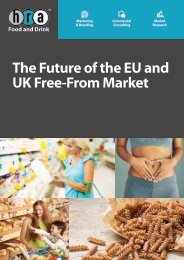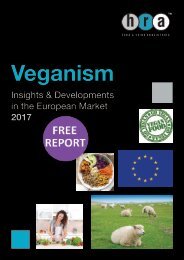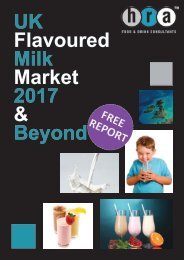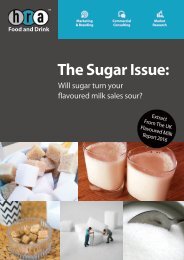FREE-UK-Flavoured-Milk-Report-2016-2017
The backdrop to the UK flavoured milk market is one of relentless change. The removal of the EU milk quotas, the transition to a Western-type diet by emerging economies, the UK sugar debate and the booming sports nutrition industry are all aspects of change that create both challenges and opportunities for the UK flavoured milk market. HRA Food and Drink Marketing has developed this report as a map to guide industry stakeholders. Although volume growth in 2014 was slightly lower than in previous years, the flavoured milk market still has plenty of room for product innovation and development. Overall, we expect the UK flavoured milk market to continue to grow over the medium term, but not without improving its nutritional profile. The sugar debate reached new heights when, in October 2015, Public Health England released a document suggesting Government intervention in the form of a sugar tax (levy). As a consequence, product reformulation has become a priority for all serious players in the market.
The backdrop to the UK flavoured milk market is one of relentless change. The removal of the EU milk quotas, the transition to a Western-type diet by emerging economies, the UK sugar debate and the booming sports nutrition industry are all aspects of change that create both challenges and
opportunities for the UK flavoured milk market.
HRA Food and Drink Marketing has developed this report as a map to guide industry stakeholders. Although volume growth in 2014 was slightly lower than in previous years, the flavoured milk market still has plenty of room for product innovation and development.
Overall, we expect the UK flavoured milk market to continue to grow over the medium term, but not without improving its nutritional profile. The sugar debate reached new heights when, in October 2015, Public Health England released a document suggesting Government intervention in the form of a sugar tax (levy). As a consequence, product reformulation has become a priority for all serious players in the market.
Create successful ePaper yourself
Turn your PDF publications into a flip-book with our unique Google optimized e-Paper software.
<strong>UK</strong>#FLAVOURED#MILK#<strong>2016</strong>217#<br />
#<br />
6.11 The Removal of EU <strong>Milk</strong> Quotas<br />
Figure 6-17: EU 28 <strong>Milk</strong> Production (million litres). Source: Dairy Co<br />
On 1 st April 2015, the long-standing EU milk quota system was lifted. In the<br />
long-term, predictions were made about redistribution of milk products in the<br />
<strong>UK</strong>, though no major changes were predicted for EU milk production.<br />
Total increase in production was forecasted at 1% for 2015/16. Since the<br />
quotas were removed, production levels have been higher than forecast and<br />
profits have declined for milk producers as milk prices have reached levels<br />
not observed since 2009 due to the weak demand and strong supply seen in<br />
the global commodity markets.<br />
As<br />
#<br />
observed in figure 6-19, EU production has generally been increasing<br />
year-on-year. This, combined with several factors that include the 2014<br />
Russian embargo on agricultural imports and subdued demand from China,<br />
has led to a decline in global demand and thus, on incomes for EU farmers.<br />
© <strong>2016</strong> Teepee Limited. All Rights Reserved.<br />
161







